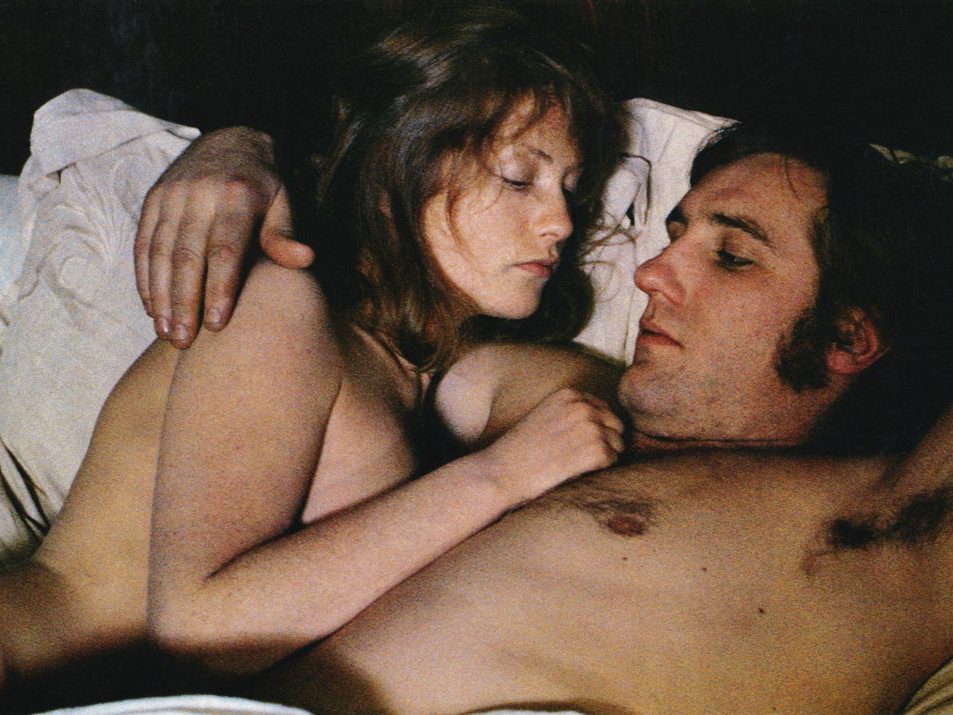
Nelly, a restless middle-class girl abandons her bourgeois friends and a steady relationship for the unemployed, leather-clad layabout, Loulou.
Which part of French cinema’s heritage do you feel you have the most in common with?
Pialat: Lumière. Pagnol. Renoir.
Maurice Pialat1
“Isabelle Huppert and Gerard Depardieu just happen to be the sexiest couple in the history of the cinema. All the time that Huppert and Depardieu are on the screen, they radiate the most dangerously anarchic sexuality one can imagine. They now belong to the ages. The first clue to the revolutionary originality of Loulou is that the name is the male's rather than the female's. Loulou is more her fantasy sex object than she his. This is a film about eroticism. I began to feel the force of Pialat's oddly stylized bedroom lyricism.”
Andrew Sarris2
“Pialat's first collaboration with actor Gérard Depardieu, in Loulou, represented the end of his search – after Jean Yanne and Phillippe Léotard – for the ultimate screen surrogate, one he would never contemplate replacing, so perfect was Depardieu’s cinematic persona as an incarnation of Pialat’s combination of softness and rage. Despite this, Depardieu would never play any version of Pialat himself. Loulou is based on a story that happened to Pialat (his girlfriend and close collaborator, screenwriter Arlette Langmann, had left him for a working class yob), but in the film Depardieu plays the ruffian, not the Pialat character.
Loulou – whose screenplay, such as it was, could not actually be completed, as Depardieu and Huppert had other projects to work on – is more fractious, fragmented, and narratively oblique than his previous titles: a film for which the audience must build up its own response to a mystifying but engrossing sexual relationship based on an accumulation of individual snapshots.
Another notable dinner table sequence, this time exterior (a single shot lasting nine minutes, taken with Jacques Loiseleux’s handheld camera), is a remarkable centerpiece that reminds us of Pialat’s taste and eye for the details of simple, provincial French life – the Pastis and oysters, the dog sitting up at the table, the coughing, the furtive looks. What could have seemed like social commentary becomes something more formally vital: a living testimony of the moment itself, with nothing chopped, cleaned, or edited in postproduction.”
Julien Allen3
France Culture's 1980 episode of ‘Le cinéma des cinéastes’ (25') where Claude-Jean Philippe received Isabelle Hupert to talk about Loulou and Sauve qui peut (la vie), released the same year. On LaCinetek, you can watch the 25' episode of ‘Ciné Regards’ of September 6, 1980 with Maurice Pialat on the set of Loulou. There's also a wealth of material on the website of the Institut National de l'Audiovisuel (INA), such as a tv interview with Huppert and Depardieu, and a portrait of the latter during the shoot. [in French]
Interview with Isabelle Huppert on Maurice Pialat’s Loulou (1980)
- 1“20 Questions for Filmmakers,” Cahiers du Cinéma, nr. 325, Juin 1981. Translated by Craig Keller.
- 2Andrew Sarris, “Films in Focus: Flash! Sexiest Couple in Film,” The Village Voice, June 9, 1980. Sarris put Loulou on #2 in his Village Voice top10 of 1980, right after Godard's Sauve Qui Peut (la vie). Sarris’s zealous review in the Village Voice is still remembered by Huppert as her best American notice.
- 3Julien Allen, “Maurice Pialat: Moments of Truth,” Reverse Shot, October 16, 2015.

